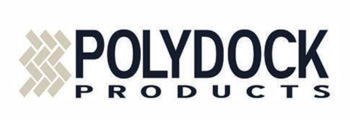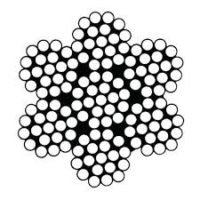
Mar 17, 2020
Wire Rope Lubricants
Wire rope lubrication is critical to extending the life of a cable (often referred to as the “lift cable”). How significant is it? Failure to complete this simple maintenance can reduce wire rope life by up to 50%.
Tell me more!
A wire rope consists of wire strands wound around a central core, then again wound around themselves to form a wire rope. The center may consist of steel or even plastics. Here are just some of the MANY different configurations for a wire rope.
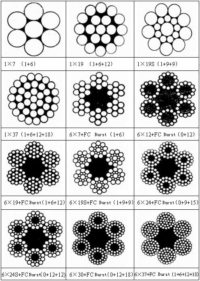
Wire Rope Configurations
The use of a small strand size is better suited to bending around small sheaves (pulleys). Taken to an extreme, a wire made of one thick “strand” would not be able to go around a pulley.
Many small strands allow the wire rope to bend easily around the pulleys. In doing so, the strands “rub” against each other, causing friction. Over time, friction rubs any external coatings off the wire rope.
How are the wire rope strands protected against rust?
Uncoated wire rope strands left “uncoated” will rust from exposure to moisture in the air;
The cable strands get a coating of zinc for rust protection (called galvanizing). The steel strands travel through a hot zinc bath to coat the surface with rust protection. The “con” to galvanized cables – the surface does not regenerate when damaged.
What about stainless steel cables?
In simplest terms, when molten high carbon steel mixes with chromium, it forms stainless steel. When in contact with air, the chrome restores the anti-rust properties. The “con” side – it gives up small amounts of strength.
What function does lubricating a wire rope perform?
Wire rope lubricants;
1. Reduce friction in the layers of the wire rope as they move over other layers. It’s true for galvanized & stainless steel cables both; and
2. Lubricants provide corrosion protection and lubrication in the core of the cable. Less rust and friction means longer life for the cables.
Are there different lubricants used?
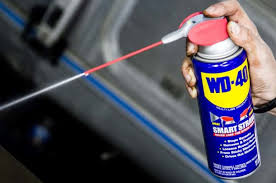
Boat Lift Cable Lubrication
There are different types of wire rope lubricants – penetrating and coating. Solvents in penetrating oils carry a lubricant into the core of the wire rope. When the solvent evaporates, it leaves behind a lubricating film to protect the strands.
“Coating” lubricants (grease) barely penetrate a cable. The coating seals the outside of the cable from moisture and reduces wear and corrosion. But, it also seals moisture inside the cable, thus promoting the rusting process.
PWS recommends only penetrating lubricants.
Most wire ropes fail on the inside first. It is vital to ensure that the center core receives enough lubrication. Repeated applications over a day are a good idea.
It is best to apply short bursts of spray lubricant on the top cables wound around the drum. Spray across the top of the wires to get the best penetration and protection. The rope strands tend to separate slightly due to bending around the winch drum. This separation allows the lubricant better access to the core of the wire rope.
Four Rules to follow:
- Do not apply a grease lubricant on a boat lift cable;
- Never change the diameter of the lift cable;
- Never substitute a different wire construction; and
- Do not replace stainless steel cables with galvanized cables.
Experience suggests that life cycles may double with lubrication. But remember, there are other factors affecting wire rope life also.
PWS attributes the increase in the life cycle to the use of penetrating oil to displace water and decrease friction. The oil reduces the wear and corrosion occurring inside the rope. Spraying with a penetrating lubricant acts like an oil change for cars. You’d never allow your vehicle to run out of oil. Right?
The savings from lubrication versus replacing a lift cable are considerable.
What else can damage a boat lift cable?
Improper winding and shock loading with heavy loads damage the cables. These actions will speed up wear and corrosion. See this link.
WHAT ABOUT MY BOAT LIFT?
In a previous post, we explained the danger to boat lift cables if the waves hit the bottom of your boat. We also demonstrated what defective wires look.
7 x 7 cable construction
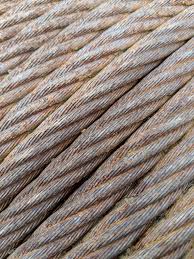
Rust on galvanized cable
Once again, here are the warning signs of defects in your cables.
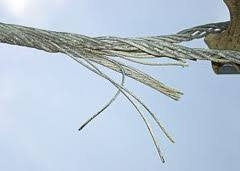
Broken Strands
If your cable looks like any of these, it’s time to replace them.
Warning – It is possible to break strands inside a cable without any exterior signs of damage. This situation is especially true on stainless steel cables which do not rust. If you see “rust” on a stainless steel cable, it is from the winch drum depositing rust in the winding process.
Visit Pier & Waterfront Solutions on Facebook also.
Tell Your Friends & Family
Have friends or neighbors you believe would like to see this article? Email them this link – they’ll thank you!
Where is PWS?
You will find us at the intersection of Idlewild Road and Hwy 57 in Door County. The address is 7325 St. Hwy 57, Sturgeon Bay. That’s 3 miles south of Sturgeon Bay, and 1 mile north of the intersection with Cty MM.
Our staff looks forward to serving ALL your waterfront needs.
Contact:
Dave @ (920) 905-2588 or Dave@wisconsinpws.com – erosion control and shoreline work.
Jerry @ (920) 493-4404 or Jerry@wisconsinpws.com – commercial work and new & used Sales.
John @ (920) 493- 4405 or John@wisconsinpws.com – Scheduling & Service work.
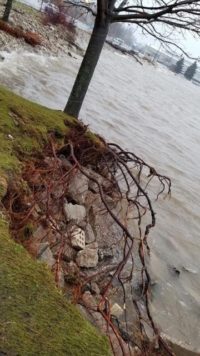
Mar 3, 2020
WILL RIP-RAP PROTECT MY SHORELINE?
Headline – Lake Michigan’s water level rose 2 inches in the final week of January alone. And – it’s still rising!
So what?
A 2-inch rise in water level doesn’t seem like a whole lot, But, did you know it takes 778.4 BILLION
(that’s Billion with a B) gallons of water to do that.
DID WE GET YOUR ATTENTION?
According to the U.S. Army Corps of Engineers, Detroit District:
“Lake Michigan-Huron is starting well above its 2019 starting levels. The 2019 levels were already at their highest in years. (The U.S. Army Corps of Engineers treat Lake Michigan-Huron as one body of water.)”
The rise in water levels placed Lake Michigan well above where it started last year. It’s fair to say that with this start, we will likely see worsening erosion in 2020.
Here’s a quote from the Army Corps of Engineers –
“The current water level for Lake Michigan-Huron is 581.69 feet. That is 3 inches higher than one month ago, 20 inches higher than where it was just a year ago and 39 inches higher than where the lake typically is in January!”
Put in simplest terms, Lake Michigan and the Bay of Green Bay are very high.
ARE WE AT RECORD LEVELS?
If the month ended on January 24th, the answer would be a resounding yes. The lake level is a whopping 5 inches above the record highest monthly average, observed in 1987!
The water not only filled the Great Lakes, but it also saturated wetlands and swamps in the watershed. Those areas have served as “sponges” to absorb the excess water in the past.
After a few wet seasons, those areas can’t hold any more water. Any rain or snow that falls now ends up pushing lake levels even higher.
When lake levels rise, the rivers and tributaries feeding the bay begin to swell with the excess water. The extra water means flooding in any low-lying areas. Remember -Those areas are also saturated.
The reality of the situation is that lakes Michigan and Huron are full. The lakes are beyond full. Don’t forget – Lake Superior is also at an all-time high.
The excess water means land that has been dry for decades is now wet. Soils that haven’t seen lake levels this high since 1986 are suddenly saturated.
THE SECOND FACTOR – WIND
The wind is the second-factor driving erosion of your shoreline.
If you have a 30 mile per hour wind (especially from the NW, in our case), on top of the high water, you get a three or 4-foot wave. The water begins to slam into the shorelines at a higher level, not seen since ’86. To make matters even worse, NE winds cause a surge in water depth.
In the past, the upper levels of your shoreline only saw waves during a few storms each year. Today, the waves are pounding the shores at much higher levels on a daily basis.
Wind-driven waves batter the shoreline – one wave after another, around the clock, day in and day out. There’s nothing unusual about continuous waves. Except, now they are battering much higher on the shoreline.
The record levels of water and strong gusty winds create a lot of energy in the form of wave action.
Rip-rap helps reduce the effects of the waves.
The waves scrub the shoreline and batter the substrate. Waves loosen the once stable and dry shore over time. Now, throw in the occasional storm, and the impact intensifies even more.
SAND BEACHES
If you have sand as your predominate substrate, the waves loosen it. Eventually, the substrate breaks down and moves with the waves. The water takes away a lot of the base that’s on your shore.
Someone once said, “A picture is worth a thousand words”. Well, here’s the picture – link. This is in Lower Michigan but the same thing is happening to the Door County peninsula shorelines. Note the protection from the rip-rap areas.
HIGH EMBANKMENTS
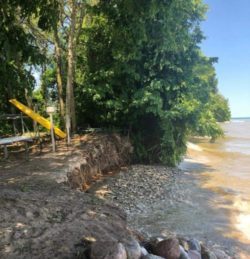
Shoreline Erosion without rip-rap
If you have a high embankment, the situation is similar to a sand beach. With higher water and saturated ground, the waves pound against the raised embankment. Only roots, weeds, and small rocks hold the soil in place.
Now wash away the soil from the embankment, and the roots can no longer hold the ground in place. The rocks become dislodged and wash away.
BEDROCK?
With high water levels, many people have no shoreline left. The waves continuously batter the bedrock walls. Every small piece dislodged from the bedrock exposes a new surface for the waves to attack.
Moisture gets into the small fissures, and the freeze-thaw cycle begins. The freeze-thaw cycle is widespread in early spring and late fall. Once the rock loosens, the waves can remove the pieces. It’s a natural cycle. Remember, the freeze-thaw period happens to roads every winter – they are called “potholes”.
WHEN WILL THIS STOP?
It will need a drop in lake levels before you don’t have to worry about losing your shoreline.
WHAT ABOUT THE WAVES?
Waves are the result of the friction between the water and winds. Mankind has no control over wind-driven waves. There is no way to control it.
Since we haven’t mastered the art of controlling rainfall or winds, there are limited things we can do to save our shorelines.
WHAT CAN YOU DO?
Since we can’t control the rain or the waves, experts say the best solution is either a seawall or rip-rap.
Seawalls are the more expensive option.
Rip-Rap is the alternative to a seawall. Rip-rap will reduce or eliminate the damage caused by high water and waves.
HOW DOES RIP-RAP WORK?
As waves move towards your shore, they absorb energy. When the waves get closer to shallow water, that energy causes the waves to rise and “curl”. This action generates turbulence at the leading edge.
Rip-rap breaks the energy of the waves by absorbing and deflecting the power across the pile. We add a permeable barrier under the rip-rap to prevent the soil from washing out under it.
WILL RIP-RAP WASH AWAY?
A “toe stone” at the bottom of the rip-rap solves this problem. The “toe stone” consists of partially buried two-ton, up to 8 1/2 ton, boulder at the leading edge of the rip-rap. They help hold the rip-rap in place during wave action.
WHO DOES RIP-RAP IN DOOR COUNTY?
Pier & Waterfront Solutions (PWS) has installed many rip-rap installations to save properties like yours. Shouldn’t they be doing yours?
IS IT COST-EFFECTIVE?
Yes, Remember, your property values decrease if people see the shorelines washed out or if your lawn was carried away by the waves. First impressions are crucial to any sale.
WANT THE WORK DONE RIGHT?
PWS has dedicated teams who do nothing but rip-rap. Contact Dave @ (920) 905-2588 or Dave@wisconsinpws.com for your erosion control and shoreline work.
Tell Your Friends & Family
Have friends or neighbors you believe should see this article? Email them this link and – Thank you!
Don’t Forget
Pier & Waterfront Solutions (PWS) specializes in:
- ShoreMaster docks, lifts, and jet ski lifts;
- Lift Boss boat lift motors;
- Accessories for docks and lifts;
- Marina construction and repairs; Plus
NEW!! Shoreline erosion control and waterfront work
Visit Pier & Waterfront Solutions on Facebook also.
PWS is located at the intersection of Idlewild Road and Hwy 57. Located at 7325 St. Hwy 57. It’s 3 miles south of Sturgeon Bay, and 1 mile beyond the intersection of Cty MM (heading north).
Contact:
Dave @ (920) 905-2588 or Dave@wisconsinpws.com for erosion control and shoreline work.
Jerry @ (920) 493-4404 or Jerry@wisconsinpws.com for commercial work and new & used Sales.
John @ (920) 493- 4405 or John@wisconsinpws.com for Scheduling & Service work










